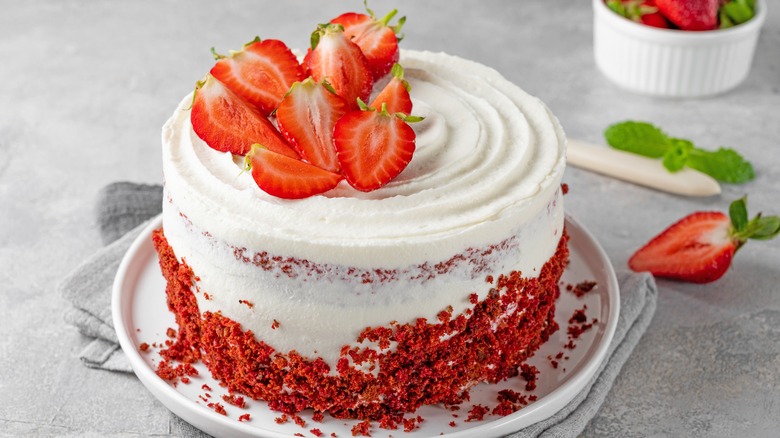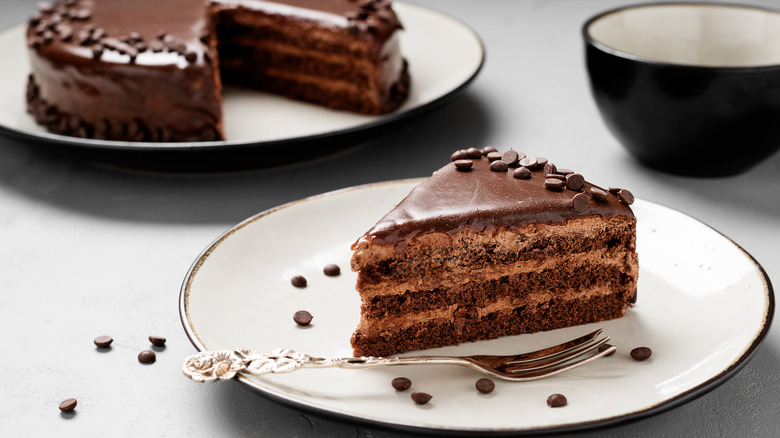Can You Really Freeze A Whole, Frosted Cake?
Baking a cake is difficult enough — it requires patience, dexterity, and attention to detail. Some would say it's both an art and a science. Plus, your job isn't done once the cake is ready (unless you plan to eat it within hours). Storing it can be quite a challenge, especially if you use cream cheese, royal icing, ganache, or other types of frosting. The same goes for store-bought cakes, which have a short shelf-life.
This dessert can last as little as two days or as long as three months, depending on the ingredients used. For example, cakes with no filling or frosting can be stored at room temperature for a couple of days or in the refrigerator for a week or so. But if you have a cake with cream cheese or buttercream frosting, you can't leave it at room temperature. Instead, allow the frosting to set and then wrap the cake with aluminum foil, parchment paper, or plastic film. When you're done, refrigerate it for five to six days. But obviously, frozen cakes will last longer.
That's right — you can freeze a whole cake, but you'll need to do some prep work beforehand. Also, note that some cakes, especially those with a creamy texture or fruit fillings, are best served fresh.
How to freeze a frosted cake without ruining it
There are several ways to freeze a frosted cake, depending on whether it's homemade or store-bought. One option is to freeze the frosting separately from the cake base. Wrap the cake in plastic or aluminum foil, prepare the frosting, let it settle, and then transfer it to a plastic bag. Seal the bag after removing excess air, label it with the date, and freeze it. Store any leftover frosting in the refrigerator or freezer, depending on its composition.
Another option is to freeze the whole cake, including the frosting or icing. First, let it cool completely to prevent the frosting from sliding off later on. Next, wrap the cake in aluminum foil or plastic film and place it in the freezer. Alternatively, transfer the wrapped cake to an airtight container before freezing it.
Generally, cakes with cheese cream or buttercream frosting tend to freeze well for up to three months. If the frosting is made with eggs, don't freeze your cake for longer than a month. Cheesecakes, mousse cakes, custard-based cakes, sponge cakes, and those made with fresh fruit, whipped cream, or pastry cream fillings are not suitable for freezing. The same goes for sponge cakes, which can dry out when exposed to cold temperatures. You can freeze them if necessary, but they may not taste the same as when fresh.
Take these steps to defrost your cake
Defrosting a cake is easy, but you should still follow some basic rules. Start by removing your cake from the freezer and taking off the wrap. Let it thaw in the fridge for several hours and then serve it as is or cut one slice at a time. You can also place it on the counter, especially if you're going to serve it over the next few hours. However, it's best to let it thaw in the refrigerator to prevent any changes in flavor or texture.
Cake leftovers can be frozen or refrigerated. If you prefer to freeze them, wrap each slice in aluminum foil and place it in a Ziploc bag.
Meanwhile, see these delicious uses for leftover cake and surprise your loved ones with a creative dessert. For example, you can turn those leftovers into cake pops, bread pudding, ice cream, or truffles. Pound cake can be repurposed as French toast, whereas cheesecake makes a great addition to milkshakes.


